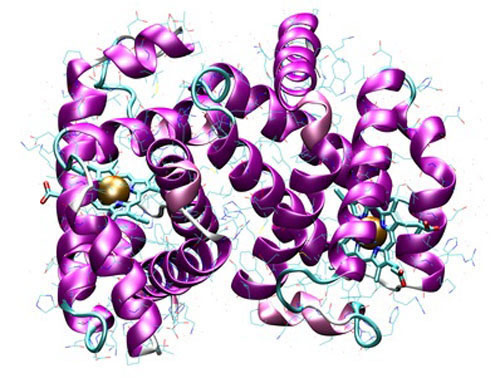![New research has uncovered how a type of fluid flow commonly encountered in manufacturing processes can affect the quality of their products. [Daniel Tackley/Fotolia]](https://genengnews.com/wp-content/uploads/2018/08/May8_2014_2578677_PurpleProtein_Histagging1111723219-1.jpg)
New research has uncovered how a type of fluid flow commonly encountered in manufacturing processes can affect the quality of their products. [Daniel Tackley/Fotolia]
Proteins represent a significant portion of the biopharmaceutical industries’ manufacturing repertoire—meaning that by extension, effective protein production and purification techniques are essential to keep the industry moving forward. Insights into improving production efficiencies and preventing damage to important biomolecules save scientists valuable time and resources.
Now, a group of investigators from the University of Leeds and MedImmune has just published findings describing how a type of fluid flow commonly encountered in manufacturing processes can affect the quality of protein compounds. This process—known as extensional flow—can be highly damaging to biomolecules dissolved in the fluid and occurs when the fluid rapidly accelerates its movement. Findings from the new study were published recently in Proceedings of the National Academy Sciences in an article entitled “Inducing Protein Aggregation by Extensional Flow.”
In the current study, the research team developed a device that was able to apply extensional flow in the laboratory and used it to study the activity of proteins held in the fluid. They found that the method can lead to an increased likelihood that a wide range of proteins, including biopharmaceuticals, would become less effective. The researchers noted that while many tests exist to assess the effects of changes in temperature or pH on protein stability, this test directly gauged the effects of fluid flows used in the manufacturing process.
“There are very few existing protein tests available to industry that actually examine how aggregation levels are related to manufacturing conditions,” explained senior study investigator David Brockwell, Ph.D., associate professor at the University of Leeds. “What we now have is a much more accurate way of predicting which proteins can be used in biopharmaceutical drug development and how processes could also be changed to improve their quality.”
Outside manufacturing, some common examples of extensional flow include syringes administering liquefied drugs or the effect on water seen when gardeners put their finger over the end of a hosepipe. In the molecular world, proteins naturally fold into specific shapes in order to operate correctly, but extensional flow can cause them to stretch and unfold, making them less useful. Moreover, once they begin to unfold, proteins stick together, or aggregate, which can block sensitive factory equipment and decrease the effectiveness of the medicines they are contained in, and can even pose a danger to people.
To test the effects of extensional flow, research engineers on the team developed a benchtop device able to very precisely control the strain exerted on proteins in fluid and the extent to which they unfolded. Using the new device to gather evidence, the researchers were able to calculate exactly the extent of the protein aggregation, creating a new evidence base for industry.
“We assessed the effects of a defined and quantified flow field dominated by extensional flow on the aggregation of BSA [bovine serum albumin], β2-microglobulin (β2m), granulocyte colony stimulating factor (G-CSF), and three monoclonal antibodies (mAbs),” the authors wrote. “We show that the device induces protein aggregation after exposure to an extensional flow field for 0.36–1.8 ms, at concentrations as low as 0.5 mg mL−1. In addition, we revealed that the extent of aggregation depends on the applied strain rate and the concentration, structural scaffold, and sequence of the protein. Finally, we demonstrate the in situ labeling of a buried cysteine residue in BSA during extensional stress.”
The investigators also found that aggregation in a range of proteins was diverse and was particularly damaging to therapeutic proteins such as biopharmaceutical antibodies under conditions similar to those found in standard manufacturing processes.
The evidence from the new device leaves the research team optimistic that they can now demonstrate maximal levels of extensional flow which manufacturers could use for different processes, without damaging proteins.
“Biopharmaceutical drugs are a growing area of medical innovation because of their success in treating a number of illnesses, but they are very expensive to produce; so any innovation that drug companies can make to improve their costs will have a significant effect,” Dr. Brockwell concluded.






